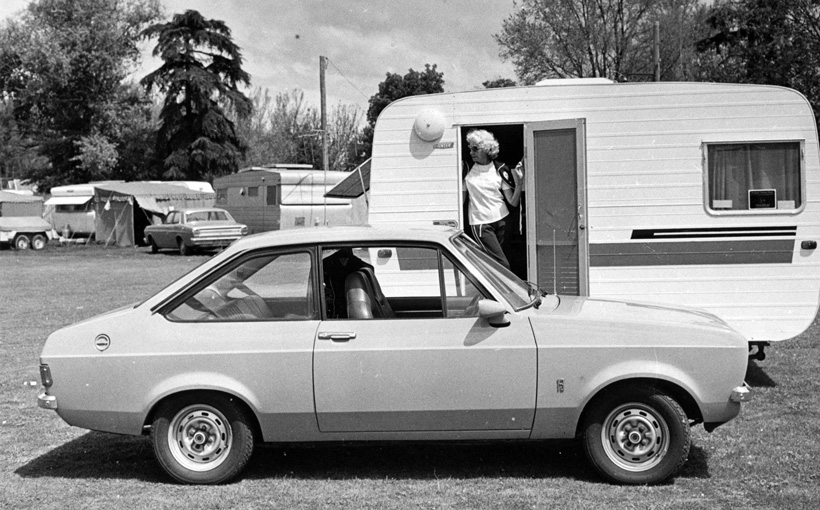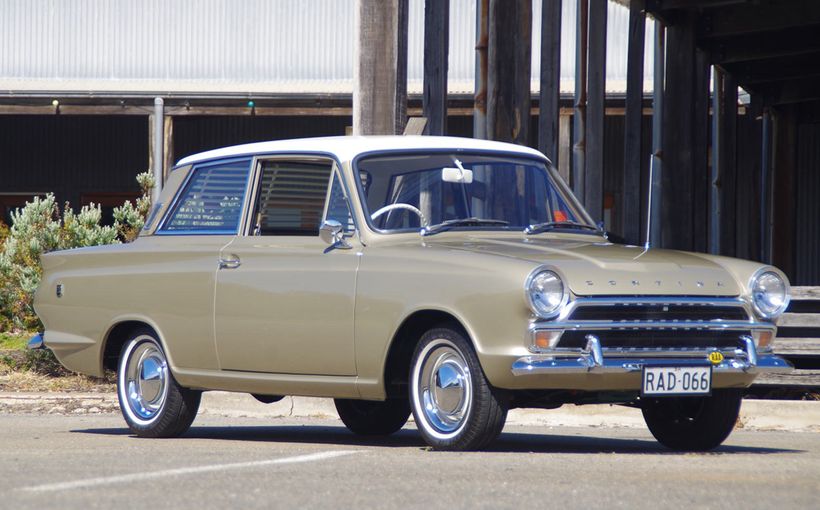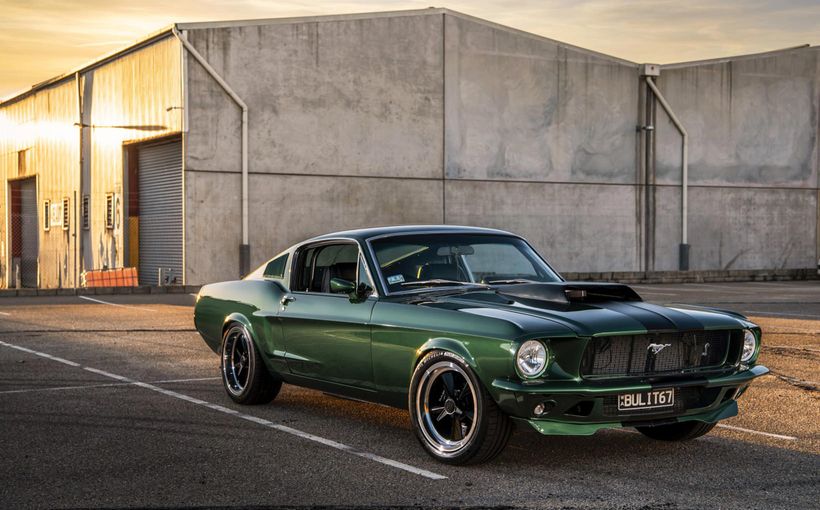Ford Escort Mark 2: cool in 1975, outdated by 1980

Could this woman possibly be called Brenda?
Hello, Brenda. Brenda was the codename for the Ford Escort Mark 2, a car with a particularly interesting background. Nowadays it’s not politically correct to assign gender to cars, but it’s fair to say that back in 1975, Brenda was a very pretty little car.
In June 1967 at a meeting in Paris, Henry Ford II decided to create a new company called Ford of Europe. John Andrews, who had been managing director of Ford-Germany for seven years, believed that Ford should pull down its own national borders and seek new synergies and convinced his boss. Andrews became the first head of Ford’s co-ordinated European activities. He believed responsibility should go where the skill was greatest, which is why the first production car – the English Transit commercial was the first vehicle – was assigned to the British operation. Famously, this was the Ford Escort which set a new template for small cars when it was launched in January 1968.
Did Ford of Europe work as well as Andrews had intended? Yes. The Escort was a great success and was also built in Germany from 1970. Brenda was by then already in the planning. She was to be designed and developed in Germany.
Uwe Bahnsen (1930-2013) headed the program and, frankly, did a first-class job. The mechanicals were carried over from the final version of the old car but the body was all new and greater attention had been paid to refinement. Slightly shorter and wider, a little taller and heavier, the Mark 2 had additional soundproofing, more comfortable seats and a higher level of standard specification.

Perhaps not a colour match made in heaven but it was the 1970s, supposedly the decade good taste forgot.
Remarkably, despite looking so new and different, the Mark 2 Escort retained the floorpan, firewall and most inner skin panels. One of the design priorities was to improve all-round vision, a shortcoming of the original model. It was just one of many significant improvements made to a car that, for all its flaws, had won a strong international following.
Perhaps the replacement of the ‘dog-bone’ grille with a more sophisticated one stands as a symbol for how the new car was to be presented. It had more polish and better road manners.

Some customers had reacted negatively to the fairly basic character of the original Escort, where some items that were standard on rivals cost extra. While the price looked highly competitive in theory, it quickly didn’t seem so good when assorted option boxes got ticked. Ford of Europe’s marketing executives recognised that buyers wanted a more ‘complete’ car, even if it happened to be quite a small one.
The Mark 2 Escort was offered in a bewildering array of variants, not all of which made the journey to Australia. Three shapes, four engines plus various stages of tune, nine trim levels and nineteen different versions ensured there was a new small Ford to suit – as General Motors’ Alfred P. Sloan, Jr had written in the corporation’s 1924 Annual Report – ‘every purse and purpose’. It was promoted as ‘The European Formula’.
Back in 1968 the original Escort championed rear-wheel drive in a British market full of Alec Issigonis-designed front-drive BMC cars. Before the Escort came the Cortina, whose chief claim to fame was that it was the largest car available in Europe for the price. Ford of Britain and then Ford of Europe came to favour a policy of mechanical orthodoxy (less complexity, lower running costs), sharp styling with a suggestion of sportiness, and lots of car for the money.
Interestingly, Ford of Germany had chosen front-wheel drive for its Cortina-sized Taunus. There does not seem to have been any agonising over which pair of wheels to drive for either the 1968 Escort or its 1975 successor. But where the original had to drive its way through front-wheel drive BMC traffic, the Mark 2 would have to make its way through increasingly competitive Japanese cars. This is another reason why Bahnsen and his team were determined to deliver a higher quality product.

The Mark 2 Escort provided a design direction for Ford. The TE Cortina, the Granada and the XD Falcon followed with a strong European feel. Just months after the new Escort went on sale in Australia, the decision – and this surely was just happenstance – was taken at Fishermans Bend to turn to Europe for the next Holden; the German designers seemed to have most of the answers.
The Escort Mark 2 was introduced in Australia on 30 September 1975. It was available in three specification levels – L, XL and Ghia. There was no Ghia version of the panel van, even though it might have been a winner, so funky were all Escorts. It’s difficult to think of a more appealing small van of the era than either the original or the Mark 2 Ford.
Despite being effectively the same size as its predecessor, the new Escort had more leg room, larger door openings and a bigger boot. It was much quieter and more comfortable. Even the entry level L variant had carpets, reclining front seats, radials, armrests on the doors and front disc brakes.
The mainstream XL model had an AM radio, heated rear window, better trim and blacked-out grille and door sills.

Cloth upholstery was rarely seen in the sub-luxury sector in the mid-1970s and was optional on, for example, the HQ Premier. The Escort Ghia set a new standard for equipment and brought a new meaning to the phrase ‘life’s little luxuries’.
With the Mark 2 Escort Ford Oz really got its act into ‘Ghia’. At launch the up-spec Ghia variant was priced at $4531 plus on-road costs. This was the first time the prestigious Ghia name had been given to an Australian Ford. While purists would never have condoned the appearance of this so-elegant logo on such obviously mass-produced panels, the Escort Mark 2 was more deserving than some models which followed in subsequent years. Carrozzeria Ghia SpA dated back to 1916. Famous designs included the Volkswagen Karmann-Ghia, Renault Floride, and Volvo P1800. The Ford buyout took place in 1970 and from 1973 the revered name was used on the most expensive variants of European Fords.
In passing, it is interesting to see how Ford Australia’s marketing department (mis)used the Ghia nameplate down the years. Incomprehensibly, the lovely decorative and historical badge was dropped on the whim of some focus group a number of years ago and replaced with ‘Ghia’ in chrome letters. Then some ‘expert’ unschooled in the automotive world decided ‘Titanium’ should replace ‘Ghia’ altogether. Whatever happened to the inspired marketing that had characterised Ford Australia’s ascension to market leadership from XA Falcon (‘The Great Australian Road Car’) days through to somewhere around 1982-83 (when the V8 was dropped and the LTD lost most of its real feeling of luxury, and so on)?

In the Australia of 1975 where the XB Falcon and HJ Kingswood still came standard with a bench seat and three-on-the tree gearbox, the Escort Ghia was a unique offering. Its price was about the same as the most basic Falcon but there was no comparison when it came to equipment. The interior was classy. If the wood trim wasn’t real it may as well have been, there was plush cloth upholstery, a carpeted boot and lower door trims, a remote-control driver’s side mirror and –oh, heights of 1975 De Luxe! – a pushbutton radio. Many Escort Ghias had vinyl roofs. It has been likened to a mini-Fairlane but a more apt comparison would be with the flagship LTD.
In terms of interior presentation the Ghia was equal in most respects to the much dearer Alfetta sedan, which certainly had genuine timber but no cloth for the seats.
Ford Australia’s marketing nous was unmatched by any direct rival in this era. The Escort Ghia represented a true high point. It was as far from a cheap-feeling economy car which was the problem for the earlier Escort as could be imagined. When, in 1977, it was fitted with the same 2.0-litre (Pinto) engine as the Cortina, it was a truly desirable little car, especially with the sweet-shifting standard four-speed gearbox.

With the Pinto 2.0-litre engine plumbed beneath Brenda’s pretty little bonnet, that proud acronym ‘OHC’ hinted at the huge increase in urge.
In November 1975 the Mark 2 Escort vans were introduced locally. Clever marketing was again evident when the GS pack was added. With sports wheels, driving lights, split front bumpers and side striping it was, as we would have said then as well as now, cool. The van craze was very much a mid to late 1970s phenomenon and no car company cashed in on it better than Ford Australia. Its Sundowner sub-brand had worked on the Falcon and even the Transit, so there was soon an Escort Sundowner complete with tinted bubble window, stripes, blacked-out grille and bumpers. The exterior was also dressed up with a full set of gauges, soft feel steering wheel per the GS pack and houndstooth trim.

Escort Sundowner: cool back then, even cooler now.
The Escort vans were impressively practical. There was good space for sleeping, thanks to tilting front bucket seats. In the rear there was a fluorescent light and an internal door release for easy escape. The floor was carpeted and the spare wheel got a vinyl cover.
In 1976 Ford Australia imported a batch of 25 RS2000s. These had the Mark 2 body with a new aerodynamically-efficient nosecone constructed from polyurethane. They also had quad quartz iodine headlights, a deep front air dam, and a rubber bootlid spoiler. But the marketing department never planned to sell this specialist model in volume. Its role was to serve as what we would now call a hero car for the Escort range.

If there was an issue with the new Escort it was the continued use of the old 1.3-litre engine. Even before the Mark 2 was being assembled in Australia, the competitive status of this engine had received a challenge from Holden’s new competitor, the Gemini days with a lusty 1.6. This issue was forced, as it were, by Australian Design Rule (ADR) 27A which was to come into effect on 1 July 1976. Ford Australia quietly dropped the small engine and made the 1.6 standard. Even so, the power-sapping effect of ADR27A requirements was such that the ‘clean’ 1.6 gave barely more performance than the ‘dirty’ 1.3. As for the ‘dirty’ 1.6, it was quoted at 60 kW while the ADR27A-compliant unit mustered a mere 44.5. That took the gloss off the Escort Ghia!

Ford Australia had a touch of genius with limited editions, shown here in the Escapee.
Again Ford’s marketing brilliance came to the fore. With the 1.6-litre engine now standard, there was new scope for dress-up packages. The Escort Escapee was a manual L with sports wheels, abundant stripery, a rear spoiler, wider (steel-belted radial) tyres, driving lights, laminated windscreen (presumable to aid interstate escaping) and the GS pack. In his road test (Modern Motor, February 1977), John Crawford noted that the Escapee was launched ‘coincidentally at the same time as the Southern Cross Rally’ but this schedule was more likely a piece of clever planning by the marketing executives.
In 1977 Ford Australia offered the 2.0-litre engine in the Escort. It was standard in the Ghia, turning that variant into a true sports sedan, a relatively inexpensive alternative to a Lancia Beta or Alfetta, and making things even tougher for the Cortina Ghia.
Significant modifications were necessary for the car to accept the larger capacity engine. The radiator was moved forward. There were revisions to the front end. A new exhaust system and sump, the bigger diameter Cortina clutch and a larger fuel tank (increased from an inadequate 36 litres to a satisfactory 55) were plumbed into the little Ford. The final drive ratio was changed from 3.75:1 to 3.54:1 for better economy and more relaxed cruising. Stronger front suspension struts and differential as well as revised spring and damper rates were also deemed necessary. By relocating the fuel filler cap behind the number plate mount, the engineers managed to increase boot capacity by 16 per cent. Ghia-type moulded seat pads were added across the range. Air-conditioning joined the options list.
In July 1977 the entry price for Escort ownership was $4317 for the 1.6-litre L panel van with the equivalent two-door sedan costing an extra $175. The GL van was $4709. The 1.6 GL two-door was $4885. A four-door GL was $5011. Specifying the bigger engine added about $200, depending on the variant. The desirable Escort Ghia waved the flag at $5828.
The Mark 2 received a minor facelift late in its local life. A Ford badge – remarkably, not the famous Blue Oval, even though this was coming back into re-use at about this time; why it was ever dropped is a mystery! – was applied to the centre of a blacked-out grille, there were square headlights and restyled wheels. The Blue Oval badge was fitted to the last of the Mark 2s, including the Sundowner. The Ghias lost their spoked sports wheels and got cast alloy wheels of the same design as the FD LTD’s. Here’s the big news: the GL and Ghia got soft feel steering wheels and an intermittent speed for the wipers.

More show, better dynamics but no more go was the disappointing story of the last Escort RS.
In one of the great anti-climaxes of the time, Ford Australia reintroduced the RS2000. This one was based on the 2.0-litre GL and was available in two- and four-door versions. But it was not the real deal, despite longer nose, sports suspension, wider tyres, extra instruments, centre console, stripes and cloth-trimmed Scheel seats. Yes, it was great value at just $6315 and handled brilliantly, but with just the standard 70 kW engine, it was no fireball.

At the time of its debut, the Mark 2 Escort was highly competitive. But by the time it was superseded by the front-wheel drive Laser, its time had obviously passed. Now, of course, enthusiasts would just love to be able to buy a brand new rear-wheel drive car of this type, but in the world of 1981 the Escort and Gemini seemed hopelessly outclassed by the new wave of Japanese offerings inspired by the Volkswagen Golf, which was actually introduced in Europe a year before the Escort. The pace of change was huge and the Escort Club which had been so cool in 1970 was no longer the place to be seen just 10 years later.









